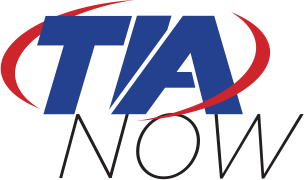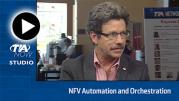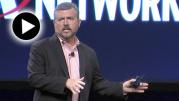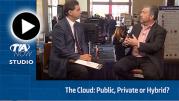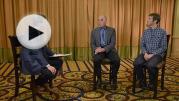Why is it so difficult to automate and orchestrate carrier networks when enterprises/clouds have been successfully doing it for several years? What are the carriers’ fears or issues with current solutions which are hindering greater deployment? Red Hat, Intel and Netscout discuss.
Red Hat
Featured Video
All Red Hat Videos:
-
Focusing on the end solution and application - enabled by network orchestration, automation and service assurance - is just one thing that Chris Wright, VP and Chief Technologist at Red Hat is tasked with. He spoke with TIA NOW about the progress around containers, container networking and the open source community, from the Open Networking Summit 2017.
-
The main ingredients for network virtualization that support the Internet of Things are skilled people, horizontal business models and a provider's willingness to listen to its users. In the Dell TIA NOW studio, we explore the synergy between NFV and IoT with Pierre Olivier-Mathys, Director of Global Telco Solutions at Red Hat and Brett Sappington, Senior Director of Research at Parks Associates.
-
Why is it so difficult to automate and orchestrate carrier networks when enterprises/clouds have been successfully doing it for several years? What are the carriers’ fears or issues with current solutions which are hindering greater deployment? Red Hat, Intel and Netscout discuss.
-
Tim Yeaton, Senior Vice President of the Infrastructure Business Group at Red Hat, tells the TIA 2016 conference audience how digital transformation and open source are changing the telco experience - and how you may incorporate what already exists in your network into an all-IP hardware and software infrastructure.
-
65% of respondents of a recent Forrester survey said they already use more than one public or private cloud platform, indicating that the hybrid cloud is a reality. So what is the source of this significant momentum for building applications that run across multiple cloud platforms? Here to tell us about this is Tim Yeaton, SVP of the Infrastructure Business Group at Red Hat.
-
Register today for TIA 2016: Network of the Future, where the communications ecosystem comes together to dream, share and discover pathways to solve the need for ubiquitous connectivity for consumers, enterprise and government. This year we focus on 5G Network Innovations, Internet of Things, Cybersecurity, and Network Virtualization – exploring the markets, technologies and policy issues for each. Keynotes include executives from AT&T, Verizon, Red Hat, Comcast, Cisco and more.
-
The explosive growth of internet traffic has disrupted the technology industry, threatening to clog telecom networks… unless a new, scalable approach is implemented. This documentary explores the evolution of Network Functions Virtualization (NFV) and the hurdles faced when switching from infrastructure-heavy, legacy networks to virtualized networks.
-
How far have we come to demonstrating and implementing an open, cloud-based NFV model to further support transformation within the telco industry? Joining us from MWC 2016 are Brian Higgins, VP of Network Planning at Verizon; Chris Wright, VP and Chief Technologist at Red Hat; Gee Rittenhouse, SVP and GM of the Cloud and Virtualization Group at Cisco and Drew Schulke, Executive Director of Next Generation Infrastructure at Dell.
-
DevOps is no longer limited to the FANG companies (Facebook, Amazon, Netflix and Google) in Silicon Valley, but now telcos are finding the value of leveraging the DevOps methodology. "DevOps is cultural shift about how we develop and deploy applications,” said Pierre Olivier Mathis, Director of Telco Global Solutions at Red Hat. Mathis says that telcos need help in transitioning from the old world to the new world, before they lose their market share to the over-the-top players.
-
Jim Whitehurst, CEO of Red Hat, joins us at MWC 2016 to tell us all how to maximize the innovation potential of our organizations. What does it mean to “catalyze direction” and why do we need to move to a post-industrialized way of working in our companies?
-
We’ve all heard about the primary benefits of NFV technologies: scalability, agility and automation, to increase time to market for our products and services. But what other benefits have emerged since MWC 2015? Miniature cloud-based replicas for deploying a steady flow of innovation into a live network can be a challenging concept to wrap your head around. Darrell Jordan-Smith, Worldwide VP of ICT at Red Hat and John Healy, General Manager of the SDN Division at Intel join us in the studio.
-
Solving telecommunications and enterprise use cases is what Dave Neary, SDN and NFV Community Strategist at Red Hat is setting his sights on. Open source and open platforms allows developers to take their source code to the service market and scale that service.
-
Moving from network lock-in to open source for NFV is partly due to do the work of Jeff Baher, Sr. Director of NFV Solutions at Dell and Chris Wright, Chief Technologist at Red Hat. Supporting software-defined networks for storage, compute and network capabilities on an open network platform has new requirements. Telcos are more than willing to welcome an open cloud platform for network communications and to further explore the benefits of open source for NFV solutions.
-
The service reliability by operators is independent of the reliability of the hardware, said Dave Neary, NFV Community Strategist at Red Hat. Neary joined Current Analysis’s Vice President of Consumer and Infrastructure, Peter Jarich as TIA NOW’s Abe Nejad moderated a panel on the importance of "five 9s" reliability for operator services - for manageability, reliability and security.
-
Darrell Jordan-Smith, Communications and Media Vertical Head at Red Hat, spoke to TIA NOW at the TIA 2015 Network of the Future conference about the importance of accepting the open source approach to networking. From the technical and economic benefits of open source to how OpenStack fits into the Cloud, Smith gives the TIA 2015 viewers a peek into the Red Hat culture.
